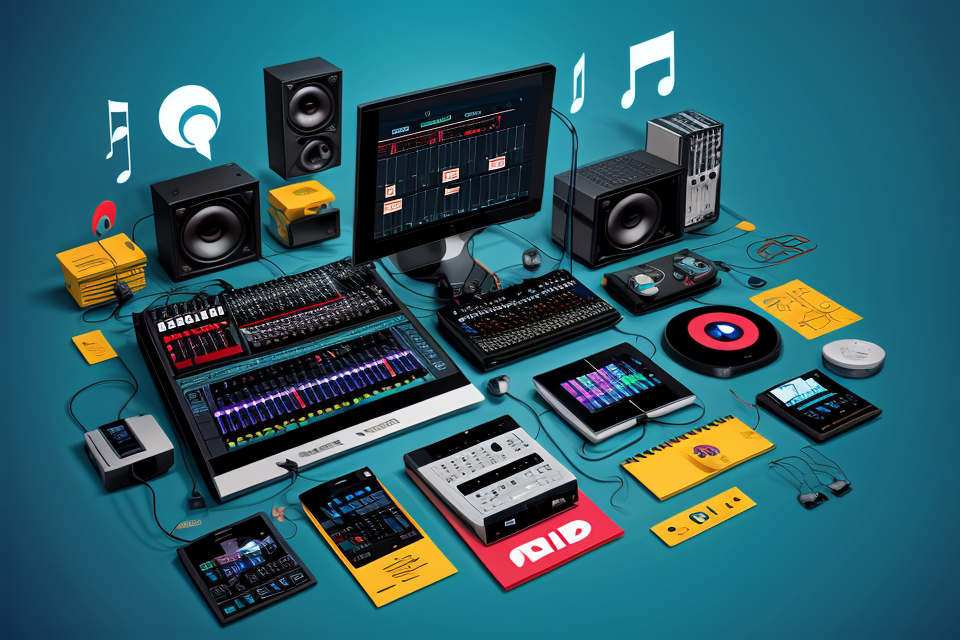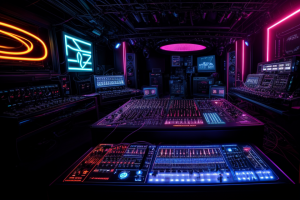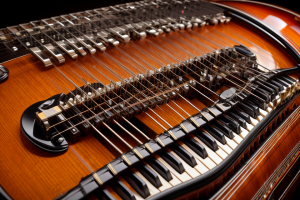
Electronic instruments have revolutionized the world of music production, offering a wide range of benefits that have made them an essential part of modern music-making. From increased versatility to improved sound quality, the advantages of electronic instruments are numerous and varied. In this article, we’ll explore the many benefits of using electronic instruments in music production, and how they can help you to create professional-sounding tracks with ease. Whether you’re a seasoned producer or just starting out, this guide will provide you with an insight into the world of electronic instruments and how they can help you to take your music production to the next level.
Using electronic instruments in music production offers a wide range of benefits. Firstly, electronic instruments are highly versatile and can produce a vast array of sounds that would be difficult or impossible to achieve with traditional acoustic instruments. This allows for greater creativity and experimentation in the production process. Additionally, electronic instruments are often more cost-effective and require less maintenance than their acoustic counterparts. They are also typically easier to transport and set up, making them ideal for live performances. Finally, electronic instruments offer greater control over the final sound, with the ability to manipulate and edit recordings in ways that were previously impossible. Overall, using electronic instruments in music production can lead to more innovative and diverse music, as well as greater efficiency and cost-effectiveness in the production process.
The evolution of electronic instruments
The rise of synthesizers
The rise of synthesizers can be traced back to the 1960s, when electronic instruments began to gain popularity in popular music. Synthesizers, in particular, revolutionized the music industry by providing musicians with a new way to create and manipulate sound.
Analog synthesizers
Analog synthesizers were the first type of synthesizer to be developed, and they used a variety of electronic components, such as resistors, capacitors, and transistors, to generate sound. These synthesizers were relatively simple in design and typically had a limited number of controls, such as knobs and sliders, that allowed musicians to adjust various parameters of the sound, such as frequency and amplitude. Despite their simplicity, analog synthesizers were capable of producing a wide range of sounds, from bass and lead lines to pads and effects.
Digital synthesizers
Digital synthesizers, which were developed in the 1980s, represented a significant departure from their analog predecessors. Unlike analog synthesizers, which generated sound using physical components, digital synthesizers used algorithms and computer programs to generate sound. This allowed for a much greater degree of control over the sound, as well as the ability to create more complex and intricate sounds. Digital synthesizers also allowed for greater flexibility in terms of editing and manipulating sounds, as well as the ability to store and recall sounds using memory.
Despite the advances in digital technology, many musicians and producers still prefer analog synthesizers for their warm, organic sound and their ability to generate sounds that are difficult or impossible to replicate using digital means. Nonetheless, digital synthesizers have become an essential tool in modern music production, and are used in a wide range of genres, from electronic and dance music to rock and pop.
Electronic drums and percussion
Early drum machines
Electronic drums and percussion have been around for decades, and their evolution has been driven by the need for versatility, flexibility, and innovation in music production. One of the earliest forms of electronic drums was the drum machine, which first appeared in the 1950s. These early drum machines were simple devices that used pre-recorded drum sounds and were often used in experimental music. However, it wasn’t until the 1970s that drum machines became more sophisticated and began to be used in popular music.
Modern electronic drum kits
Today’s electronic drum kits are a far cry from their early counterparts. Modern electronic drum kits are equipped with a variety of sensors and pads that can detect the movement and pressure of each drumstick. This technology allows for greater precision and flexibility in playing, as well as the ability to create complex drum patterns and sounds. Electronic drum kits also offer a number of other benefits, such as the ability to adjust the volume of each drum separately, and the ability to connect to other electronic devices and software for further editing and manipulation. Additionally, electronic drum kits are generally more durable and easier to transport than traditional acoustic drum kits, making them a popular choice for touring musicians and recording studios.
Other electronic instruments
Apart from synthesizers, there are other electronic instruments that have been developed and utilized in music production. These instruments include samplers and effects processors.
Samplers
Samplers are electronic instruments that allow musicians to record and reproduce sounds. The first sampler was created in the late 1960s, and since then, they have become an essential tool in music production. Samplers can be used to create new sounds by sampling and manipulating existing sounds, or they can be used to emulate the sound of acoustic instruments. Samplers have revolutionized the way music is produced, as they have made it possible to create complex textures and layers that would be difficult or impossible to achieve with traditional instruments.
Effects processors
Effects processors are electronic devices that alter the sound of an instrument or voice. They can be used to add reverb, delay, distortion, and other effects to the sound. Effects processors have been used in music production since the 1960s and have become an essential tool for creating new sounds and textures. They can be used to create unique and creative effects that would be difficult or impossible to achieve with traditional instruments. Effects processors have also made it possible to manipulate the sound of an instrument or voice in real-time, allowing musicians to create dynamic and expressive performances.
Improved sound quality and versatility
Unique sounds and textures
Electronic instruments offer a vast array of unique sounds and textures that are not available with traditional acoustic instruments. With the ability to manipulate and modify electronic signals, musicians and producers can create an endless variety of sounds that would be impossible to achieve with physical instruments alone.
One of the main advantages of electronic instruments is the ability to create new and original sounds. Electronic instruments can produce a wide range of timbres, from classic analog synth tones to futuristic digital sounds. These unique sounds can be used to create entirely new genres of music or to add a fresh twist to existing styles.
Another benefit of electronic instruments is the ability to create complex and intricate textures. With multiple layers of sound and the ability to manipulate individual elements, electronic instruments can create dense and rich sounds that are perfect for building a complex musical landscape. This is particularly useful in genres such as ambient, electronic, and experimental music, where intricate textures are often used to create a sense of atmosphere and mood.
Electronic instruments also offer a range of sound design capabilities that are not available with traditional instruments. With the ability to manipulate and modify electronic signals, musicians and producers can create a vast array of sounds that would be impossible to achieve with physical instruments alone. This includes the ability to create custom synthesizer patches, use audio effects processors, and manipulate audio samples in a variety of ways.
Overall, the use of electronic instruments in music production offers a wealth of benefits, including improved sound quality, versatility, and the ability to create unique sounds and textures. Whether you’re a producer, musician, or sound designer, electronic instruments can help you to create new and exciting sounds that will take your music to the next level.
Greater control over the music production process
Real-time manipulation
Electronic instruments provide the ability to manipulate sound in real-time, allowing for immediate changes to be made to the music production process. This enables musicians and producers to quickly adjust and experiment with different sounds and effects, resulting in a more dynamic and expressive final product.
Automation and sequencing
Electronic instruments also offer the ability to automate and sequence various aspects of the music production process. This means that musicians and producers can program specific sounds and effects to occur at certain points in the song, creating a more precise and polished final product. Automation and sequencing can also save time and effort by eliminating the need for manual adjustments during the production process.
Increased efficiency and productivity
Time-saving techniques
Electronic instruments provide musicians and producers with various time-saving techniques. These include features such as automation, sample-based instruments, and virtual instruments. Automation allows users to record and manipulate various parameters, such as volume and filter cutoff, in real-time, reducing the need for manual adjustments. Sample-based instruments, like sample-based synthesizers, allow users to access a vast library of sounds and quickly create complex patterns. Virtual instruments, like software synthesizers and drum machines, offer even more flexibility, as they can be used in a variety of genres and can be easily edited and manipulated.
Collaboration and remote work
Electronic instruments have made collaboration and remote work easier than ever before. With the help of the internet, musicians and producers can now collaborate with others from anywhere in the world. Cloud-based software and file-sharing platforms make it easy to share and collaborate on projects, and remote recording technology allows musicians to record their parts from their own studios, saving time and money. This flexibility has also allowed for more diverse and creative collaborations, as musicians and producers can now work with others from different parts of the world, bringing different styles and influences to their music.
The impact of electronic instruments on music production
Changes in music styles and genres
Electronic instruments have significantly impacted the music industry by introducing new styles and genres that were previously unimaginable. These innovative tools have enabled musicians to push the boundaries of creativity and experiment with different sounds, textures, and rhythms. In this section, we will explore the changes in music styles and genres that have emerged as a result of electronic instruments.
Electronic dance music
Electronic dance music (EDM) is a genre that has been heavily influenced by electronic instruments. EDM producers use a wide range of electronic equipment, such as synthesizers, drum machines, and digital audio workstations, to create complex soundscapes and intricate rhythms. Electronic instruments have enabled EDM producers to produce music that is highly dynamic and versatile, with an extensive range of sonic possibilities. As a result, EDM has become one of the most popular genres in the world, with a global audience that spans across cultures and generations.
Experimental music
Electronic instruments have also played a significant role in the development of experimental music. Experimental music is a genre that explores the limits of conventional music and pushes the boundaries of what is considered “normal” or “conventional.” Electronic instruments have enabled experimental musicians to create sounds that are otherworldly and impossible to replicate with traditional instruments. These sounds are often used to create immersive and evocative sonic landscapes that challenge the listener’s perception of sound and music.
Overall, the use of electronic instruments has significantly expanded the possibilities of music production, leading to the emergence of new styles and genres that were previously unimaginable. These innovative tools have enabled musicians to push the boundaries of creativity and explore new sonic territories, resulting in a diverse and vibrant music industry that continues to evolve and expand.
Advances in music technology
Electronic instruments have revolutionized the music industry by introducing innovative software and hardware technologies that have greatly impacted music production. Some of the advances in music technology include:
Software and hardware innovations
One of the significant advantages of electronic instruments is the integration of software and hardware technologies. These innovations have made it possible for musicians to create, record, and produce high-quality music with ease. Electronic instruments have been designed with built-in software and hardware components that enable musicians to produce music with greater precision and accuracy. For instance, digital audio workstations (DAWs) have made it possible for musicians to record, edit, and mix music using a computer. This has enabled musicians to have more control over the music production process, making it easier to experiment with different sounds and styles.
Integration with other technologies
Electronic instruments have also been integrated with other technologies, such as virtual reality (VR) and artificial intelligence (AI), which have expanded the possibilities of music production. For example, VR technology has enabled musicians to create immersive musical experiences that transport listeners to different environments. AI technologies have been used to create music that mimics human creativity, providing musicians with new tools to enhance their music production process. These technologies have expanded the possibilities of music production, making it possible for musicians to create unique and innovative sounds that were previously impossible.
In conclusion, the advances in music technology have had a significant impact on music production, enabling musicians to create high-quality music with ease. The integration of software and hardware technologies, as well as the integration with other technologies such as VR and AI, have expanded the possibilities of music production, making it possible for musicians to create unique and innovative sounds that were previously impossible.
The future of electronic instruments in music production
Electronic instruments have had a profound impact on music production, and this impact is only set to grow in the future. As technology continues to advance, we can expect to see continued innovation and development in the world of electronic instruments.
Continued innovation and development
One of the key benefits of electronic instruments is their ability to be easily updated and modified. This means that as technology advances, electronic instruments can be easily adapted to take advantage of new developments. For example, as new materials and manufacturing techniques are developed, electronic instruments can be redesigned to incorporate these advances, leading to improved sound quality and new creative possibilities.
In addition, electronic instruments can be easily programmed and modified using software, allowing for a level of customization that would be impossible with traditional acoustic instruments. This means that electronic instruments can be tailored to meet the specific needs of individual musicians and producers, providing a level of personalization that is not possible with other types of instruments.
Expanding possibilities for musicians and producers
As electronic instruments continue to evolve, they are providing musicians and producers with an ever-increasing range of creative possibilities. For example, new software and hardware technologies are allowing for the creation of entirely new sounds and textures, opening up new avenues for musical exploration.
In addition, electronic instruments are allowing for greater collaboration between musicians and producers, as they can easily share and exchange digital files, allowing for the creation of complex musical compositions from a distance. This is opening up new opportunities for collaboration and creativity, and is helping to drive the development of new musical styles and genres.
Overall, the future of electronic instruments in music production looks bright, with continued innovation and development set to provide musicians and producers with an ever-increasing range of creative possibilities. Whether you are a seasoned professional or just starting out, electronic instruments are an essential tool for any musician or producer looking to push the boundaries of their creativity.
FAQs
1. What are electronic instruments?
Electronic instruments are musical instruments that use electronic circuitry to generate or modify their sound. Examples include synthesizers, drum machines, and digital audio workstations (DAWs).
2. What are the advantages of using electronic instruments in music production?
One advantage of using electronic instruments is that they offer a wide range of sounds and tones that are not possible with traditional acoustic instruments. This allows musicians and producers to create unique and innovative sounds that can enhance their music.
Another advantage is that electronic instruments are often more portable and easier to transport than traditional instruments. This makes them ideal for musicians who need to travel or perform in different locations.
Electronic instruments also offer greater control over the sound and tone of the instrument. This allows musicians and producers to fine-tune the sound to their exact specifications, creating a more personalized and unique sound.
Additionally, electronic instruments can be used to create complex and intricate rhythms and melodies that would be difficult or impossible to achieve with traditional instruments. This makes them ideal for creating electronic and dance music, as well as other genres that require intricate and precise rhythms.
3. Are electronic instruments easy to use?
Electronic instruments can be easy to use, depending on the specific instrument and the user’s familiarity with technology. Many electronic instruments, such as synthesizers and drum machines, have simple controls and are easy to operate. However, some instruments, such as digital audio workstations (DAWs), can be more complex and require a certain level of technical knowledge to use effectively.
4. Can electronic instruments be used in live performances?
Yes, electronic instruments can be used in live performances. Many electronic instruments, such as synthesizers and drum machines, are designed for live performance and are easy to transport and set up. Additionally, electronic instruments can be used in conjunction with traditional instruments to create unique and innovative sounds and textures.
5. Are electronic instruments expensive?
The cost of electronic instruments can vary widely, depending on the specific instrument and its features. Some basic electronic instruments, such as simple synthesizers and drum machines, can be relatively inexpensive. However, more advanced and high-end electronic instruments, such as digital audio workstations (DAWs) and complex synthesizers, can be quite expensive.







